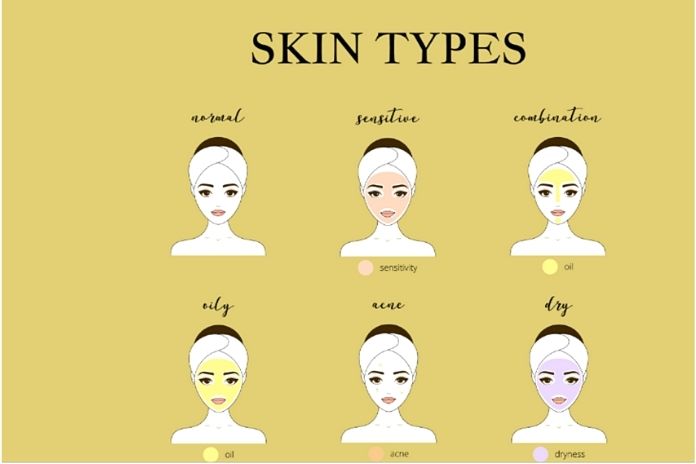So that you can resort to the proper care, you have to know what skin type you are. Here you will find an overview of them all and the essential facts. Every skin is different: while one needs more attention, the other reacts to the slightest touch with blemishes and red spots. To find the proper care for your skin, you first have to determine your skin type. We’ll give you an overview of all skin types – from regular to sensitive skin. If you want to find out in advance what skin type you are, you can do our test directly:
Normal Skin
Your skin feels plump and healthy – neither too dry nor too greasy? How nice! It is very likely that you have “normal” and therefore perfect skin that is particularly easy to care for. Even beauty experiments won’t unbalance your skin. The sebum production and the moisture content are absolutely in balance with normal skin – the rosy and fine-pored complexion shows this. Skin blemishes also rarely or never occur with standard skin types. Nevertheless: Even the most beautiful skin is exposed to daily stresses such as UV rays and free radicals. Protect your skin with the proper care to keep it healthy and glowing.
The Skin Type Characteristics For Normal Skin At A Glance:
- The skin is plump, healthy, and in balance
- Hardly to any impurities
- Fine pores
- Rosy complexion
Sensitive Skin
Pretty sensitive! Sensitive skin, or even sensitive skin, tends to have red spots, itching, and dry spots if something does not suit it – for example, significant temperature differences, sunbathing, solid winds, or certain ingredients in beauty products. But not only do external factors annoy sensitive skin, stress and food intolerances can also play a role. You don’t know what causes your skin to redden or itchy to burning areas again and again? Our tip: keep a skin diary and list exactly over several weeks which products you use, what you eat, how you feel, and what your skin looks like. This will also help the dermatologist make a diagnosis in case you need to ask for advice.
The Skin Type Characteristics For Sensitive Skin At A Glance:
- Dry spots
- Easily irritated
- Red stain
- Itching and burning
The Proper Care For Sensitive Skin
If you have sensitive skin, you should be careful when choosing skincare products. Fortunately, there are now numerous products that are precisely tailored to sensitive skin:
Dry Skin
If the skin is itchy and tight, it most likely lacks moisture and sebum. The skin appears dry, feels rough to flaky, and can even become cracked. It is more prone to inflammation and wrinkles on the forehead and around the eyes. The skin barrier of dry skin is often disrupted, and the skin can no longer store sufficient moisture. This shows not only through dry facial skin but also through the dry scalp and dry hair. Dry skin is also particularly itchy on the feet, hands, elbows, and lower legs. Anyone who suffers from dehydrated skin should see a doctor and clarify possible diseases associated with dry skin or trigger it (e.g., neurodermatitis). After all: people with dry skin rarely have blemishes,
The Skin Type Characteristics For Dry Skin At A Glance:
- Hardly any impurities
- The skin itches and tightens
- fine-pored
- Tends to wrinkle
- Skin feels rough or flaky and can become cracked
- Dryness in other parts of the body as well
Oily skin
Is your skin gleaming? Even if you cleaned your face just a few hours ago? You then likely have oily skin due to excessive sebum production. This permanently creates an oily film over the face. The result: the sebum collects on the skin’s surface, clogs the sebum pores, and impurities arise. The scalp, cleavage, and back can also be affected. The scalp quickly becomes greasy, and pimples keep forming on the body. The only advantage: Oily skin is less prone to premature wrinkling. If you have severe imperfections or acne, ask your trusted dermatologist for help.
The Skin Type Characteristics For Oily Skin At A Glance:
- large pores
- oily film and shine on the skin
- Blemishes/pimples
- late wrinkling
Combination skin
Is your skin dry and oily at the same time? Then you have combination skin. Your problem area is the familiar “T-Zone” – forehead, nose, and chin. Here the skin is oily, large-pored, and prone to pimples. On the other hand, the skin on the cheeks, around the eyes, and on the nostrils is dry to normal. Combination skin, like all skin types, can be genetically determined. However, certain factors can make symptoms worse or better. Eat a healthy and balanced diet and drink at least two liters of water a day. Your challenge: The T-zone must be gently degreased, and the dry areas urgently need moisture.
The Skin Type Characteristics For Combination Skin At A Glance:
- T-Zone: oily, large-pored, prone to pimples
- The cheeks are dry or normal
Also Read:GREEN TEA – EFFECTS ON SKIN AND HAIR

